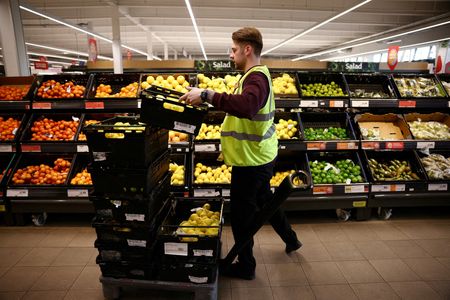
By James Davey
LONDON (Reuters) – British supermarket group Sainsbury’s forecast full-year profit towards the upper end of its guided range as a better-than-expected performance in general merchandise drove a 5.9% rise in underlying sales for the Christmas quarter.
The UK’s second largest supermarket chain after Tesco had previously forecast 2022-23 underlying pre-tax profit of between 630 million and 690 million pounds ($767-$840 million). It made 730 million pounds in 2021-22.
Prior to the update analysts were on average forecasting 644 million pounds, according to a company compiled consensus.
Ahead of Christmas, European retailers worried that the key trading period could be the worst in at least a decade.
But in Britain, despite UK inflation running at 10.7% and consumer confidence close to record lows, major retailers that have reported so far have performed well.
Sainsbury’s figures back up industry data showing Britain’s grocers performed relatively strongly in the Christmas quarter, likely gaining share of overall spend from non-food retailers.
The group, which has a 15.5% share of Britain’s grocery market, said total retail sales over the 16 weeks to Jan. 7, excluding fuel, rose 5.2%, reflecting inflation and “relatively resilient volume trends”.
Grocery sales rose 5.6%, while general merchandise sales increased by a better-than-expected 4.6%.
Sainsbury’s owns the Argos general merchandise business.
“Investment in value, innovation, service and product availability delivered stronger volume trends across grocery and general merchandise, particularly at Christmas,” CEO Simon Roberts said.
He said households managed their budgets differently, hosting larger gatherings again following two years of pandemic restrictions and treating themselves at home.
“Customers shopped early, buying Christmas treats and fizz more than once and looked for deals, taking advantage of Black Friday and other seasonal offers,” said Roberts.
He noted that as train and postal strikes disrupted Britain, Argos benefited from its reliability and convenience.
Sainsbury’s is spending 550 million pounds over the two years to March 2023, funded by cost savings, to keep a lid on grocery prices and encourage shoppers not to switch to discounters Aldi UK and Lidl GB.
However, Roberts said he was cautious on the consumer backdrop.
“We understand money will be exceptionally tight this year particularly as many people wait for Christmas bills to land,” he said.
UK consumers face the prospect of an even tighter squeeze on their finances in 2023, with higher taxes and mortgage rates and scaled back government support on household energy bills.
(Reporting by James Davey; editing by William James and Jason Neely)

